Posted by Elena del Valle on December 10, 2012

Phil Cooke, author, One Big Thing
Photo: Phil Cooke
A podcast interview with Phil Cooke, author, One Big Thing is available in the Podcast Section of Hispanic Marketing & Public Relations, HispanicMPR.com. During the podcast, he discusses discovering your purpose in life with Elena del Valle, host of the HispanicMPR.com podcast.
Phil has been an agent of change for millions of people through his work in television and the media. He lectures at Yale University, UC Berkeley and UCLA, and spent the past 30 years advising many large organizations. He has appeared on MSNBC, CNBC, CNN and Fox News, and his work has been profiled in The New York Times, Los Angeles Times, and The Wall Street Journal. He is also the author of Jolt! Get the Jump on a World that’s Constantly Changing (Thomas Nelson, 2011). He blogs on change, disruption, culture, and media.
To listen to the interview, scroll down until you see “Podcast” on the right hand side, then select “HMPR Phil Cooke” click on the play button below or download the MP3 file to your iPod or MP3 player to listen on the go, in your car or at home. To download it, click on the arrow of the recording you wish to copy and save it to disk. The podcast will remain listed in the December 2012 section of the podcast archive.
Posted by Elena del Valle on December 7, 2012

Looking for Esperanza book cover
Photos: Benu Press
While watching the news the attention of Adriana Paramo, an author and anthropologist, was drawn to a story about an immigrant mother who had carried her dead daughter’s body with her through a tough desert journey from Mexico with her family. Perhaps because she is an immigrant herself or because the plight of others touches her the woman’s case drew Paramo. She spent 18 months searching for Esperanza, the woman in the news, immersing herself in the world of undocumented workers in the small town where she thought Esperanza might live.
Across Florida, in vegetable fields, citrus groves, ferneries, and packing houses, she encountered “an underground subculture of hungry undocumented women, a hidden world of wage slaves, a microcosm of false names, false Social Security numbers, and false hopes.” During that time, she met many people and heard about many unfortunate women and their sorrow filled stories.
She stopped writing following the death of her mother due to her extended bereavement. Eight years after she began her search for Esperanza Looking for Esperanza: The Story of a Mother, a Child Lost, and Why They Matter to Us (Benu Press, $24.95), a 142-page softcover book about her experience, was published. The book chronicles the plight of undocumented women living in Florida who took great risks hoping for a better life for those they love.
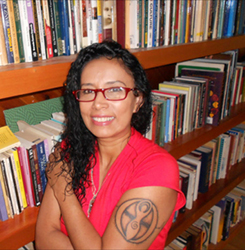
Adriana Paramo, author, Looking for Esperanza
“Although I write almost exclusively about women, I hope my readership is comprised by both men and women. Anyone with a beating heart, anyone with a shred of humanity in them, anyone with hope for a world where justice and equality rule our immigration policies and our relationship with food, is a good target for my book,” said Paramo in response to a question about the target audience for her book.
She believes the book “has brought awareness to the appalling living and working conditions of our undocumented farmworkers” and has also “created a sort or urgency, a need for the reader to say ‘what can we do?’ or ‘how can we change this?’” Two college professors plan to use the book in their classroom.
“My biggest challenge was to accept my limitations as an anthropologist. As a social scientist all I could do was to observe, document and report. With each story told to me, I wanted to do something tangible and immediate; I wanted to have the power to find them better housing, better food, to give them access to the same resources I have access to. It was very hard to realize and accept my own helplessness,” said Paramo when asked about challenges and rewards of writing the book. “To have the book published. Holding the book in my hands makes me feel that I have done something relevant, that Paulina, Laura, Griselda, Rosa, Cristina and Esperanza are no longer faceless, voiceless wetbacks, but women like me.”
Paramo, a non fiction writer born and raised in Colombia, won the 2011 Benu Press Award for Social Justice for this book. She is a resident of Florida.

Click to buy Looking for Esperanza
Comments:
Filed Under: Books
Posted by Elena del Valle on December 3, 2012
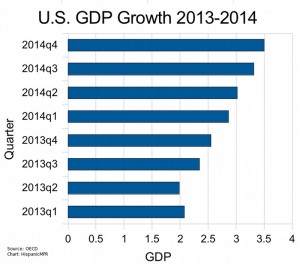
U.S. GDP Growth 2013-14 – click to enlarge
Assuming fiscal cliff issues are overcome the economy will continue a steady recovery over the coming two years, according to researchers at Organization for Economic Co-operation and Development (OECD). Our GDP is projected to grow 2 percent next year and 2.8 percent in 2014. Compared to Europe, estimated to remain in a recession and contract through the end of 2012 and into 2013 before reaching a GDP growth of 1.3 percent, the projections for the United States seem positive. Even when compared with GDP growth across the OECD of 1.4 percent for 2013 and 2.3 percent for 2014, the expectations of the United States appear promising.
“The world economy is far from being out of the woods,” said Angel Gurría, secretary-general, OECD during the Economic Outlook launch in Paris last week. “The US ‘fiscal cliff’, if it materialises, could tip an already weak economy into recession, while failure to solve the euro area crisis could lead to a major financial shock and global downturn. Governments must act decisively, using all the tools at their disposal to turn confidence around and boost growth and jobs, in the United States, in Europe, and elsewhere.”
With 50 million jobless people in the OECD area, according to the Outlook it’s no wonder the OECD head expressed concern. The report indicated continued high in employment with a possible rise in many countries “unless structural measures are used to boost near-term employment growth.”
Some developing countries, on the other hand, show desirable growth for the coming twenty four months. China is expected to grow at 8.5 percent next year and 8.9 percent the year after that. Other countries expected to grow at healthy rates are Brazil, India, Indonesia, Russia and South Africa.
Slides of the presentation are available at http://www.slideshare.net/OECD/oecd-economicoutlook92%20 on the OECD website. The mission of the Organisation for Economic Co-operation and Development is to promote policies that will improve the economic and social well-being of people around the world.
Posted by Elena del Valle on November 30, 2012
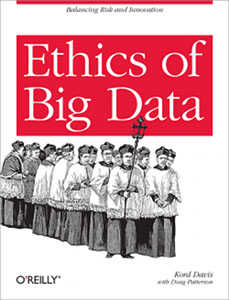
Ethics of Big Data book cover
Photos: O’Reilly Media
Big Data, the gathering of enormous sets of information on individuals, has become part of doing business. Retailers rely on it to offer products their customers have browsed or purchased in the past based on individual profiles and detailed information they keep on their customers activities on and offline in proprietary websites, social media sites and from other sources. In some cases retailers have developed the ability to guess a customer’s interests based on certain behaviors. This was the case earlier this year when it became known that a chain store was able to guess when a customer was likely to be pregnant causing a wave of controversy.
A recent The Washington Post article (Who are the doctors most trusted by doctors? Big data can tell you.) by Ki Mae Heussner explored what doctors think of their peers in a big picture way. According to that article, an activist is examining referral information gathered from government sources through a Freedom of Information Act request and creating a DocGraph designed to outline the relationships between physicians. The graph seeks to chart, relying on Big Data, how doctors interact with each other, refer patients and select doctors for themselves.
In Ethics of Big Data Balancing Risk and Innovation (O’Reilly Media, $19.99) Kord Davis and and Doug Patterson, ask readers about their organization’s policies for gathering and using huge datasets of personal information. In the 82-page softcover book the authors examine Big Data ethical questions and propose to readers that businesses should take into account issues of privacy and identity when making policy decisions about data gathering and storage.
They believe a company’s use of data can directly affect brand quality and revenue. As examples they point to Target, Apple, and Netflix. They suggest companies should align their behaviors with company values in order to preserve the trust of customers, partners, and stakeholders. The book is divided into four chapters: Big Data, Big Impact; Values and Actions; Current Practices; and Aligning Values and Actions
Davis, former principal consultant with Cap Gemini, has spent nearly 20 years providing business strategy, analysis, and technical consulting to 100 organizations including Autotask, Microsoft, Intel, Sisters of Mercy Healthcare, Nike, Bonneville Power Administration (BPA), Northwest Energy Alliance (NEEA), and Bill & Melinda Gates Foundation. Patterson has experience teaching business ethics and as a facilitator of conceptual topics.

Click to by Ethics of Big Data
Comments:
Filed Under: Books
Posted by Elena del Valle on November 26, 2012

Denise Larson, cofounder, NewMediaMetrics
Photo: NewMediaMetrics
A podcast interview with Denise Larson, cofounder, NewMediaMetrics is available in the Podcast Section of Hispanic Marketing & Public Relations, HispanicMPR.com. During the podcast, she discusses brand attachment of Hispanic consumers with Elena del Valle, host of the HispanicMPR.com podcast.
Denise developed the Emotional Attachment approach and metric in 1997 and acquired patent pending status in 2002. She founded Thinking Right, LLC where she applied Emotional Attachment to clients such as Kraft and P&G. In 2004, Denise partnered with Gary Reisman to found NewMediaMetrics.
To listen to the interview, scroll down until you see “Podcast” on the right hand side, then select “HMPR Denise Larson” click on the play button below or download the MP3 file to your iPod or MP3 player to listen on the go, in your car or at home. To download it, click on the arrow of the recording you wish to copy and save it to disk. The podcast will remain listed in the November 2012 section of the podcast archive.
Posted by Elena del Valle on November 16, 2012
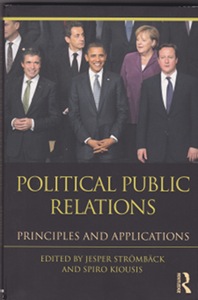
Political Public Relations book cover
Photos: Spiro Kiousis, Jesper Stromback
In Political Public Relations: Principles and Applications (Routledge, $49.95), a 338-page softcover book published in 2011 targeting an audience of students and practitioners with an interest in the developing field, fifteen men and three women, many of them in academia, discuss political public relations. The editors of the book, Spiro Kiousis, PhD*, and Jesper Stromback, PhD, believe that although political public relations plays an important role in society little theorizing or research takes place.
They participated in the book project to encourage integrative theory and research to connect public relations, political communication, political science and related fields. Stromback is Lubbe Nordström Professor and chair in Journalism, and professor in Media and Communication at Mid Sweden University, Sundsvall, Sweden. Kiousis is associate professor and chair of the Department of Public Relations, College of Journalism and Communications, University of Florida.
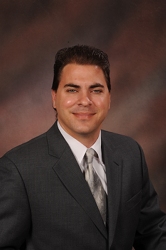
Spiro Kiousis, co-editor, Political Public Relations
“The recent presidential election campaign highlighted the ongoing importance of effective public relations and communication in winning an election. While the temptation to relegate traditional strategies and tactics as obsolete is high, the success of each candidate at different phases of the campaign rested on their ability to use both traditional channels (such as debates) or social media channels (such as YouTube), said Spiro Kiousis, co-editor, Political Public Relations by email.”
The book includes fifteen chapters. The first two chapters define political public relations and identify its roots. The next two are about news management, agenda indexing and building. The next chapters address political campaigning and presidential elections. The remaining chapters discuss corporate issues, political marketing, strategic framing, crisis communication, relationship management, government communication, digital issues, research and future issues as well as diplomacy, foreign relations and global political public relations.
“Oftentimes public relations in politics is misunderstood as being only about spin och news management, but at heart, political public relations is about organizations seeking to establish, build an maintain beneficial relationships and reputations with its key publics to help support its mission and achieve its goals. As such, public relations has always been an intrinsic part of politics and is key to long-term success both when campaigning and governing, and this book highlights both the principles and applications of public relations in politics,” said Stromback by email.

Jesper Stromback, co-editor, Political Public Relations
The book’s definition of political public relations is “the management process by which an organization or individual actor for political purposes, through purposeful communication and action, seeks to influence and to establish, build, and maintain beneficial relationships and reputations with its key publics to help support its mission and achieve its goals.” A book related website, political-public-relations.com, most recently updated September 2012 and run by the editors, extends the conversation beyond the book.
In addition to Kiousis and Stromback, the contributing authors are Paul Baines, PhD, W. Timothy Coombs, PhD, Mathew Eshbough-Soha, PhD, Guy J. Golan, Kirk Hallan, Robert Heath, PhD, Nigel Jackson, John A. Ledingham, PhD, Paul S. Lieber, Darren G. Lilleker, Diana Knott Martinelli, PhD, Juan Carlos Molleda, PhD, Karen Sanders, Kay Sweetser, PhD, John C. Tedesco, PhD, and Damion Waymer, PhD.
*Elena del Valle and Spiro Kiousis serve on the University of Florida Public Relations Advisory Council
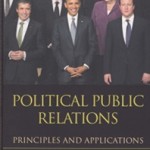
Click to buy Political Public Relations
Comments:
Filed Under: Books
Posted by Elena del Valle on November 13, 2012
Information provided by Event Partner
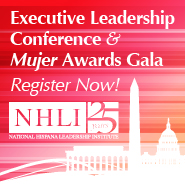
NHLI 2012 Executive Leadership Training Conference and Mujer Awards December 9–11, 2012 in Washington D.C.
The National Hispana Leadership Institute’s 2012 Executive Leadership Training Conference and Mujer Awards brings together Latinas and NHLI’s accomplished alumnae from across the nation for two days of cutting-edge leadership and professional development, networking, educational and inspirational keynotes and workshops facilitated by top-level Latinas from across the country.
At the Mujer Awards Gala, celebrated since 1993, which will be held on Monday, December 10, NHLI will close the conference by paying tribute to the achievements and contributions of exceptional Latina leaders. Past honorees have included journalist and TV anchor Maria Elena Salinas, NCLR’s President Janet Murguia, and actresses Rosario Dawson and Eva Longoria.
Conference attendees include local and national leaders in corporate America, non-profits, government, media, higher education, as well as entrepreneurs, students, artists, authors and others.
We look forward to seeing you on December 9–11, 2012 in Washington D.C.!
http://nhli.org/conference_register.htm
Posted by Elena del Valle on November 12, 2012
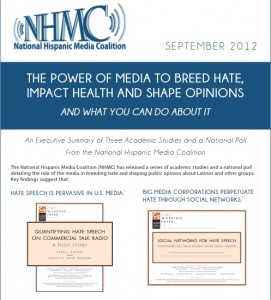
Earlier this year the National Hispanic Media Coalition (NHMC) released the findings of academic studies and a national poll that outline the role of the media in “breeding hate and shaping public opinion about Latinos and other groups.” The organization’s leadership believes the research presented “underscores the need for accuracy and fairness in our media.”
The research indicates that hate speech on commercial talk radio has led to social network interest in the radio program hosts and their guests; and that this social network passes its content to affiliated social media websites, resulting in voices promoting hatred toward people of color, people of certain religions and LGBT people. According to the report, “Media personalities and political figures representing the Republican Party and/or affiliated with the Tea Party dominate the social network, leaving little room for alternate points of view. Media powerhouses such as Premiere Radio Networks, a wholly-owned subsidiary of Clear Channel Communications, and Fox News are key components of this social network.”
A poll of non-Latino Americans found that their source of news is often television. Sixty six percent of respondents to the poll said they watch major network and cable newscasts for information and 30 percent said they trust Facebook, Twitter, and other social networks or online-only news sources. These individuals rely on news and entertainment media in forming impressions about Latinos and immigrants, according to poll analysts. The poll led researchers to conclude that Latinos and immigrants are commonly portrayed negatively in news and entertainment media prompting many non-Latinos to believe that “media-promoted negative stereotypes about these groups are true.”
The poll analysis indicates that conservative talk radio and Fox News audiences while less likely to be personally familiar with Latinos are more likely to hold anti-immigrant and anti-Latino views. Some survey respondents erroneously, according to the executive summary, believe that Latinos and undocumented immigrants are the same, and 17 percent of survey respondents said they believe that the majority of United States Latinos are undocumented.
The results of the studies were published in the UCLA Chicano Studies Research Center. They are: Quantifying Hate Speech on Commercial Talk Radio from November 2011, Social Networks for Hate Speech Commercial Talk Radio and New Media from July 2012 by Chon A. Noriega, director, UCLA Chicano Studies Research Center, and Francisco Javier Iribarren and Using Biological Marketers to Measure Stress in Listeners of Commercial Talk Radio by Hermes J. Garban, Iribarren and Noriega.
The UCLA Chicano Studies Research Center supports interdisciplinary, collaborative, and policy-oriented research. The W.K. Kellogg Foundation provided support to make the research possible. Matt A. Barreto, Sylvia Manzano, and Gary Segura of Latino Decisions produced and designed the research study, and implemented the data collection. The National Hispanic Media Coalition was founded in 1986 to increase positive portrayals of Latinos in media, based on a fundamental understanding that the media has the power to shape opinions of and behavior towards Latinos and other demographic groups.























